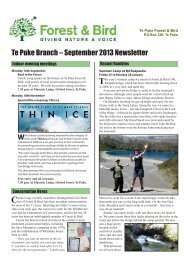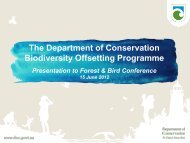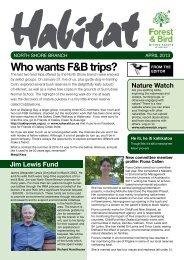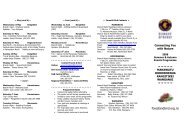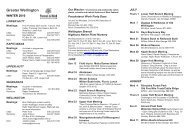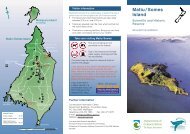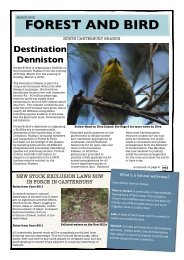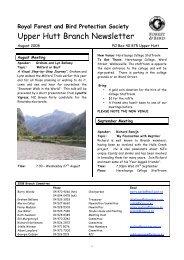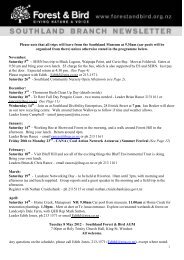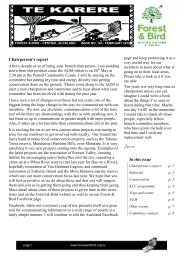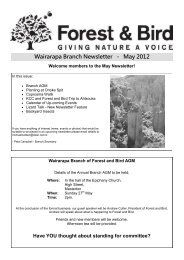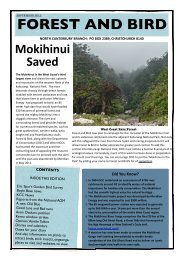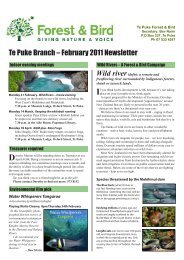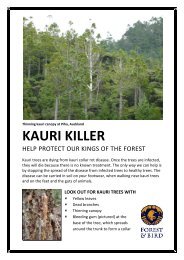methodology - Forest and Bird
methodology - Forest and Bird
methodology - Forest and Bird
You also want an ePaper? Increase the reach of your titles
YUMPU automatically turns print PDFs into web optimized ePapers that Google loves.
Fishing debris <strong>and</strong> lost commercial gear can continue to harm marine wildlife for an indefinite period<br />
(eg, entanglement), killing protected or globally threatened species of marine mammals <strong>and</strong> seabirds<br />
as well as non-target fish.<br />
Active fishing methods such as dredging <strong>and</strong> trawling generally have a greater impact on the seafloor than<br />
passive techniques such as longlining <strong>and</strong> gillnetting. The degree of impact caused by various techniques<br />
varies with depth, type of seafloor <strong>and</strong> weight or type of gear used (Collie et al.,., 2000). The scale of<br />
impact can be substantial. For example, a trawler making three trawl tows of six hours each, using bottom<br />
trawl gear with 100 metres between the doors, at an average of three knots, would bulldoze the bottom<br />
over an area of about 10 km 2 (10 trawlers could cover an area greater than the size of Wellington Harbour<br />
every day) in one day (Cryer et al.,., 2002).<br />
The approach taken in the assessment is consistent with article 6.5 of the UN FAO Code of Conduct on<br />
responsible fisheries. This general principle requires:<br />
“6.6 Selective <strong>and</strong> environmentally safe fishing gear <strong>and</strong> practices should be further developed <strong>and</strong><br />
applied, to the extent practicable, in order to maintain biodiversity <strong>and</strong> to conserve the population<br />
structure <strong>and</strong> aquatic ecosystems <strong>and</strong> protect fish quality. Where proper selective <strong>and</strong><br />
environmentally safe fishing gear <strong>and</strong> practices exist, they should be recognized <strong>and</strong> accorded a<br />
priority in establishing conservation <strong>and</strong> management measures for fisheries. States <strong>and</strong> users of<br />
aquatic ecosystems should minimize waste, catch of non-target species, both fish <strong>and</strong> non-fish<br />
species, <strong>and</strong> impacts on associated or dependent species.”<br />
The destructive impact of bottom trawling <strong>and</strong> dredging, for example in deepwater <strong>and</strong> on seamounts, has<br />
been highlighted in numerous studies (Dayton et al., 1995; Gray et al.,., 2006; Jones, 1992; Kaiser et al.,.,<br />
2006; Thrush & Dayton, 2002).<br />
The impact of trawling on “flat” areas has also been highlighted by a 2002 review of the impact of bottom<br />
trawling for scampi, tarakihi <strong>and</strong> gemfish in 200-600m of water in the Bay of Plenty (Cryer et al.,., 2002).<br />
Cryer et al., found a significant impact on a range of benthic biodiversity based on research trawls<br />
undertaken over three years. They considered the impact to be indicative of the effects of trawling<br />
occurring throughout the fisheries management area.<br />
The impact of bottom trawling on seamounts including hills <strong>and</strong> other bottom features has been well<br />
documented by a number of researchers (Clark & Rowden, 2009; Williams et al.,., 2010). The resilience of<br />
these features, particularly those “dominated by cold water corals is low compared to most other marine<br />
systems” (Clark, 2009; Williams et al.,., 2010).<br />
The area covered by trawling over the whole zone “increased from 85,448 km 2 in 1990 to a peak of 166,233<br />
km 2 in 1998” in middle depth <strong>and</strong> deep water fisheries (Ministry for the Environment, 2010). “In 2008, 68<br />
large (>28 m) fishing vessels conducted 38,648 seabed trawls covering 85,222 km 2“ (Ministry for the<br />
Environment, 2010)."<br />
A report by the Marine Conservation Biology Institute (Chuenpagdee et al.,., 2003; Morgan &<br />
Chuenpagdee, 2003) examined the collateral impacts of different fishing methods in the United States<br />
based on a survey 70 participants in fisheries management <strong>and</strong> a workshop of 13 experts. The report,<br />
Shifting Gear, was based on responses by marine biologists who ranked the effect of different fishing gear<br />
by habitat damage 7 <strong>and</strong> the severity of marine damage 8 including bycatch 9 .<br />
7 ―Habitat damage‖ – damage to living seafloor structures (eg corals, sponges, bryozoans) as well as alteration to the geologic structures (eg<br />
boulders, cobbles, gravel, s<strong>and</strong>, mud) that serve as nursery areas, refuges, <strong>and</strong> homes for fishes <strong>and</strong> organisms living on or near the seafloor.<br />
8 ―Collateral damage‖ – unintentional or incidental damage to sealife or seafloor habitat caused by fishing activities directed toward other types of<br />
sea life. Collateral impact includes bycatch <strong>and</strong> habitat damage.‖<br />
9 ―Bycatch: those species taken in a fishery targeted on other species, or a different size range of the same species <strong>and</strong> includes that part of the<br />
catch that has no commercial value <strong>and</strong> is discarded alive, injured or dead. Three classes:<br />
Economic bycatch – species discarded because they are of little or no economic value (eg in poor condition or non-marketable);<br />
Regulatory bycatch – marketable species discarded because of management regulations (eg size limits, allocations or seasons);<br />
<strong>Forest</strong> & <strong>Bird</strong> Best Fish Guide 2012 – 2013: Criteria for Ecological Rankings 13



